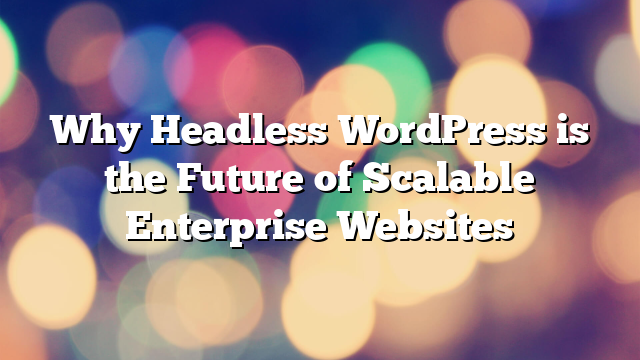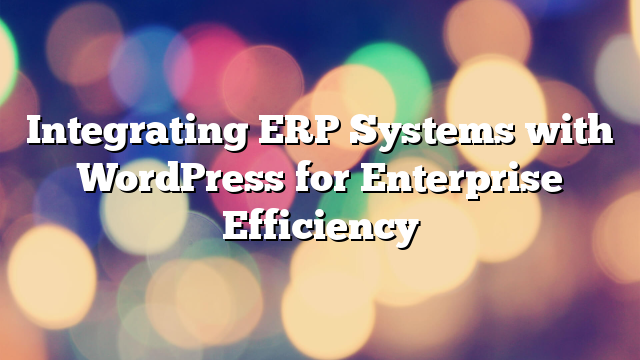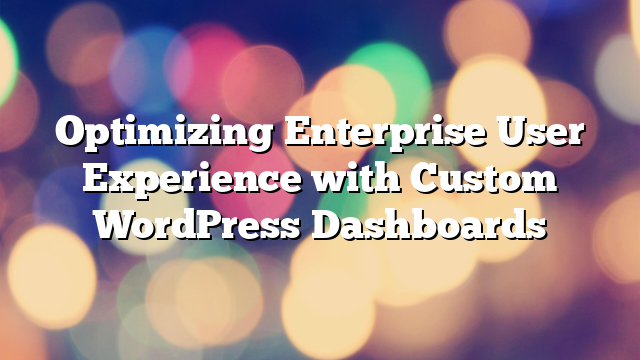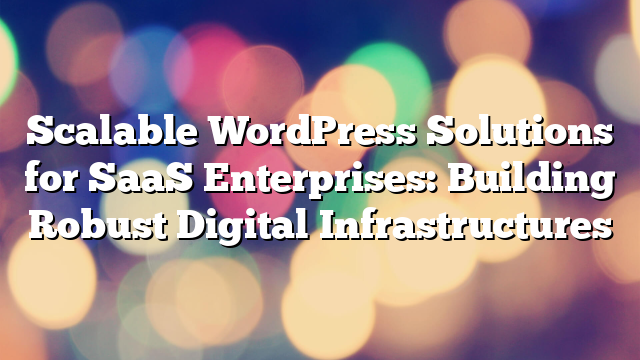Why Headless WordPress is the Future of Scalable Enterprise Websites
07.01.2025

As businesses continue to evolve, so do their digital strategies. Traditional WordPress sites, which tightly couple the front-end and back-end, may no longer be able to support the demands of modern enterprises. Enter Headless WordPress, a solution that decouples the back-end content management system from the front-end, offering new levels of flexibility, performance, and scalability. In this article, we’ll explore why Headless WordPress is quickly becoming the future of scalable enterprise websites and how it can help businesses thrive in an ever-changing digital landscape.
What is Headless WordPress?
Headless WordPress is a modern approach to content management that separates the back-end (content creation, storage, and management) from the front-end (the website’s display layer). Instead of rendering HTML in the traditional WordPress manner, the front-end is decoupled, allowing developers to use any technology to build the user interface while still leveraging WordPress as the content management system (CMS).
This decoupling of the front-end and back-end through APIs (such as the WordPress REST API) allows businesses to create more customized, responsive, and high-performance digital experiences across a variety of platforms, including websites, mobile apps, IoT devices, and even digital kiosks.
1. Scalability: The Key Advantage of Headless WordPress
For enterprise-level businesses, scalability is critical. As your business grows, your website must be able to handle increased traffic, data, and content without compromising performance. Headless WordPress allows enterprises to scale their digital experiences more effectively. By decoupling the back-end from the front-end, businesses can make changes to the user interface without impacting the core functionality and content management system.
For example, with Headless WordPress, your team can build a mobile app or a new website using modern JavaScript frameworks (like React or Next.js) without having to worry about the limitations of a traditional WordPress theme. You can use the same back-end to deliver content to multiple touchpoints, scaling your website and applications as your business grows. This flexibility allows enterprises to expand their digital footprint while maintaining performance.
2. Flexibility to Choose Your Front-End Technology
Traditional WordPress websites come with predefined themes and templates, limiting the flexibility of design and development. With Headless WordPress, you can use any front-end technology to create the user interface. Whether you prefer React, Vue.js, Angular, or Next.js, Headless WordPress allows you to choose the framework that best suits your needs, providing more control over the look, feel, and functionality of your website or application.
For enterprises, this flexibility is a game-changer. Whether you need a single-page application (SPA) for a fast and smooth user experience or an entirely custom-designed website, Headless WordPress can handle it all. By separating the front-end from the back-end, you can also create personalized user experiences that are optimized for different devices, ensuring consistency across web and mobile platforms.
3. Improved Website Performance and Speed
Website performance is crucial for user experience and SEO. Headless WordPress allows enterprises to optimize performance by serving only the necessary content to the front-end. Because content is delivered through APIs instead of being hardcoded into a theme, the front-end can be optimized for faster load times, which is especially important for large-scale websites that serve global audiences.
Additionally, Headless WordPress sites can be cached more effectively, leading to faster load times even during peak traffic periods. By decoupling the front-end, developers have full control over how and when content is fetched, allowing them to implement advanced performance optimization techniques like server-side rendering (SSR), static site generation (SSG), or content delivery networks (CDNs).
4. Multi-Channel Content Delivery
Modern enterprises are no longer just websites – they are interconnected ecosystems with multiple digital touchpoints. Headless WordPress allows you to deliver content to a variety of platforms, including websites, mobile apps, digital signage, smart devices, and even social media platforms. The content stored in WordPress can be accessed through APIs and served to these different channels, creating a seamless experience for customers no matter where they interact with your brand.
This multi-channel delivery is especially important for enterprises that want to maintain consistent messaging across different platforms. Whether you’re serving content on a web page, a mobile app, or a smartwatch, Headless WordPress makes it easy to manage all your content in one central hub while distributing it across multiple devices and channels.
5. Future-Proofing Your Website with Headless WordPress
One of the greatest advantages of Headless WordPress is its ability to future-proof your website. As technology continues to evolve, Headless WordPress gives businesses the flexibility to adopt new platforms and technologies without the need to overhaul their entire site. Want to integrate augmented reality (AR) or virtual reality (VR) into your website? No problem. Looking to add new types of digital devices into your ecosystem? Headless WordPress can handle it.
Since the front-end and back-end are decoupled, businesses can continue to innovate and adopt emerging technologies without being held back by their content management system. Whether you’re planning to leverage artificial intelligence, chatbots, or next-generation IoT devices, Headless WordPress ensures that your site will remain adaptable and ready for the future.
6. Better Security and Control
Security is always a concern for enterprise websites, and Headless WordPress offers improved security compared to traditional WordPress sites. With Headless WordPress, the back-end and front-end are separate, which reduces the risk of attacks targeting the front-end of the site. This separation ensures that any vulnerabilities on the front-end don’t directly affect the back-end content management system.
Furthermore, Headless WordPress allows for more granular control over security measures, such as authentication, data access, and API permissions. Enterprises can implement more robust security protocols and protect sensitive data, while also minimizing exposure to potential threats.
Conclusion
Headless WordPress is rapidly becoming the go-to solution for building scalable, flexible, and high-performance websites for enterprises. By decoupling the front-end from the back-end, businesses can create custom user interfaces, improve website performance, and scale their digital presence across multiple channels. With the ability to integrate emerging technologies and future-proof their websites, enterprises can maintain a competitive edge in an increasingly digital world.
If you’re considering Headless WordPress for your enterprise website, contact AllWebDev for expert guidance on implementing a headless solution tailored to your business needs.



